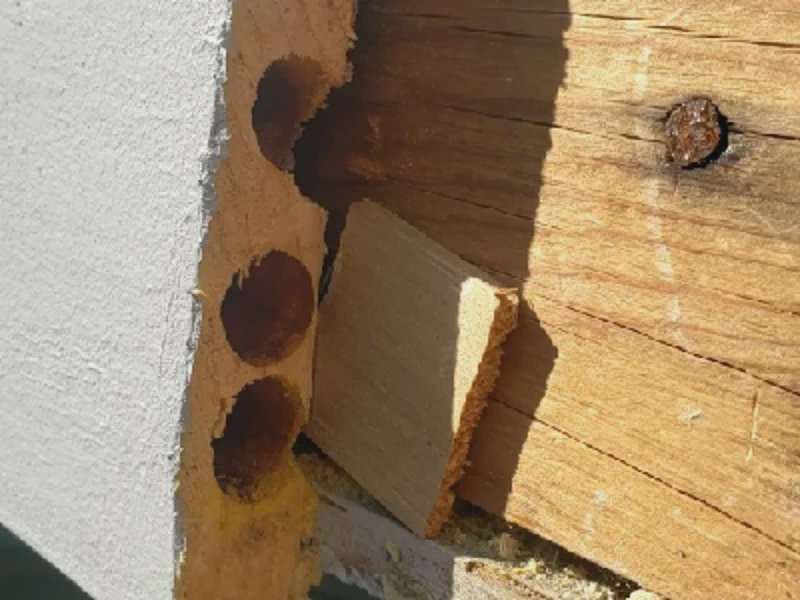
The Myth
There’s a common belief that carpenter bees only target old, untreated wood—or that a coat of paint will keep them at bay.
If only it were that simple.
What We See in the Field
At Pest UnHABITAT, we’ve found active carpenter bee nests in all kinds of structures—including new builds and freshly finished surfaces:
- Painted fascia boards
- Pergola joists made from brand-new pressure-treated lumber
- Exposed roof rafters, including on new sheds, garages, and homes
- Top plates of fences built with pressure-treated wood
- Joists of upper-level decks made with new pressure-treated lumber
- ¾-inch pressure-treated boards forming soffits of backyard sheds
These are just a few examples. Carpenter bees aren’t limited to bare or aging wood—and paint alone offers little protection.
They also don’t necessarily start at the end grain. While they sometimes drill there, we more often see them bore directly into the wood face, traveling about an inch or two in before turning sharply to tunnel along the grain—sometimes for several feet or more.
Once inside, they carve out multiple chambers or galleries where eggs are laid. The result is rarely a single, straight tunnel.
What They Look Like—and How They Act
Carpenter bees are often mistaken for bumblebees. Here’s a quick tip for telling them apart:
- Carpenter bees have shiny, smooth black abdomens that reflect light.
- Bumblebees have fuzzy abdomens that don’t reflect light.
As for behavior, male carpenter bees are harmless—but extremely territorial. They act as nest guards, chasing away birds, squirrels, flies—and people. They’re bullies. Their flight often forms a long, arching path, and they’re capable of hovering nearly motionless in place, much like hummingbirds.
This harassing behaviour is often what prompts people to contact us. The bees prevent families from enjoying their decks or backyards, especially when they repeatedly dive toward anyone who comes near the nesting site.
You may have heard that it’s best to stay still around bees—and with male carpenter bees, which don’t sting, that’s true.
But in reality, when a large bee comes zipping at your face, you won’t have time to determine if it’s male or female—or even if it’s a carpenter bee or a bumblebee. Given their similar size and shape, accurate identification takes experience. In the heat of the moment, staying still may not be the wisest choice.
Why It Matters
Carpenter bees drill round, clearly visible entry holes—up to ½ inch in diameter. From there, they hollow out long, smooth tunnels that can easily stretch several feet. These galleries may interconnect, branch off, and expand over time—creating an extensive hidden network.
Common signs of carpenter bee activity include:
- A dry, rhythmic chewing sound—like someone chewing chips, each bite spaced about a second apart
- Fine sawdust (frass) falling or collecting beneath entry holes—sometimes drifting down slowly, other times emerging in clumps
- One or more perfectly round holes, often larger than ¼ inch; several may appear if bees have reused the site over multiple seasons
At one property, we removed a painted fascia board to inspect what appeared to be a single active hole. While only one showed signs of recent use, the tunneling extended far beyond what was visible on the surface.
It was a clear reminder that surface damage doesn’t always reflect the scale of internal activity—and why thorough inspection and strategic treatment are essential.
Unlike wasps or bumblebees, which abandon their nests each fall, carpenter bee queens remain in the same wood throughout winter. In spring, they resume tunneling—and their female offspring often start new nests nearby, sometimes in the same board.
What You Can Do
Unfortunately, paint and wood finishes rarely deter carpenter bees.
But there are two effective preventive steps:
- Install sheet metal flashing along fascia, soffits, and trim to block access. Bees can’t chew through metal.
- Seal existing round holes—whether from past bee activity, fasteners, or knots. These visual cues attract carpenter bees and are often reused or expanded if left open.
For outdoor structures like pergolas or decks, flashing may not be practical. In those cases, early detection and timely action are key.
Signs to Watch For
- New, perfectly round holes in wood—especially larger than ¼ inch
- Fresh sawdust falling or collecting directly beneath a hole
- A dry, rhythmic chewing sound—repeating every second or so—from inside exposed wood
- Large bees hovering near wood trim, or flying in wide arcs
- Bees that resemble bumblebees but have shiny black abdomens—especially around flowers near wooden structures
Don’t Let It Spread
If you’re noticing these signs, carpenter bees may already be active.
Contact us today—we’re here to assess the situation and help prevent further damage. For expert carpenter bee pest control in Toronto, call Pest UnHABITAT now.